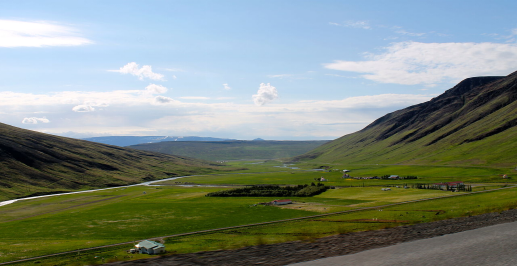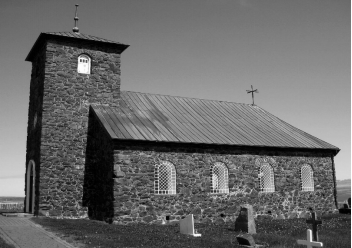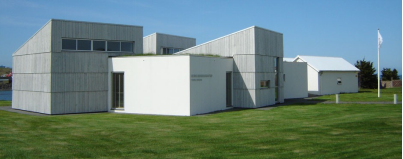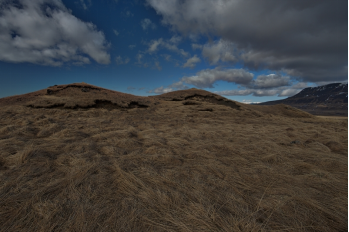Húnavatnshreppur 作者: 来源: 发布时间:2021-09-30
一、所属省或是州,具体位置,人口,面积
he rural community Húnavatn ( isl. Húnavatnshreppur ) is located in northwest Iceland in the former county of Austur-Húnavatnssýsla .
On January 1, 2019, the community had 371 inhabitants (55th largest in Iceland), and a total area of 3,822.2 square kilometers (8th largest area). The seat of the municipal administration is in Blönduós .

二、自然地理
1.地理条件
The municipality stretches in a slightly south-easterly direction from Húnafjörður, part of the large Húnaflói Bay, to the highlands to the Hofsjökull glacier. In the south is Hveravellir with its hot springs. The Langjökull glacier is located in the southwest of the municipality.
The highland slope Kjölur leads from Hveravellir through the entire municipality to the neighboring town of Blönduós. East of the Kjölur, the river Blanda is dammed to form the 57 km² large reservoir Blöndulón. Another body of water is the Hóp lagoon lake, which lies on the border with the neighboring municipality of Húnaþing vestra to the west. East of the Hóp is the eponymous lake Húnavatn.
In the north of the municipal area of the lake is Svínavatn which the river Svínadalsá , bounded by the Svínadalur is flowing fed. To the west of the lake is the Vatnsdalsfjall massif and the Vatnsdalur.
Hveravellir volcanic system exhibits many typical features of high temperature areas. There are hot water springs here, such as the Bláhver ("blue spring") surrounded by sintered terraces, fumaroles and the hissing solfatare Öskurhöll ("roaring hill"). Bræðrahver and Eyvinderhver are small spring springs. Quite unusual for Iceland are the sintered terraces formed by volcanism. The geothermal area has been a nature reserve since 1960.
Langjökull is the second largest glacier in Iceland. Such larger glaciers are known as ice caps. It is located in the west of the country and in 1989 covered an area of 950 km². In 2006 its area had already shrunk to 925 km². In the same year it had a volume of 195 km³, the ice layer was up to 580 m thick and it was at altitudes between 1450 and 400m.
Significantly, one encounters various data on the height or volume of the glacier in the literature: Old measurements were not as accurate as new ones, and glaciers are constantly changing, partly due to general climate change, partly also, for example in Iceland, due to changes in the volcanic activity under the glacier. The glacier reached its greatest thickness in 1840.
Surrounding communities are in the north Blönduós, in the east Skagafjörður, in the south Bláskógabyggð, in the southwest Borgarbyggð, in the west Húnaþing vestra.
https://de.wikipedia.org/wiki/H%C3%BAnavatn
2.交通情况
The distance to Reykjavík is 239 km via the National Ring Road.
www.google.com/maps
三、经济发展和规模
The annual accounts of Húnavatnshreppur are prepared in accordance with the Local Government Act, the Act on Annual Accounts and the Regulation on accounting, budgets and annual accounts of municipalities.
The municipality's operating income for the year amounted to ISK 469.8 million. kr. according to the annual accounts for Parts A and B, of which operating income of Part A ISK 459.2 million kr.
The tax rate was 14.52%, which was the statutory maximum. Class A property tax rate was 0.50% but its statutory maximum is 0.625% with a surcharge. In Class B, the tax rate was 1.32%, which is the statutory rate and In category C, the tax rate was 1.65%, which is the statutory maximum with a tax.
The operating result of the municipality according to the annual accounts of parts A and B was negative by 17.6 million kr. And Operating result Part was negative by ISK 11.7 million. kr. according to the income statement. The municipality's equity at the end of the year 2019 was 390.2 million. kr. according to the balance sheet for Parts A and B, but the equity of Part A amounted to ISK 429.9 million. kr.
https://www.hunavatnshreppur.is/is/stjornsysla/fjarmal
四、产业特点重点项目
The economy in Húnavatnshreppur is monotonous with agricultural about 64% of jobs, in particular sheep farming. Another economic activity is exclusively in service. The level of service is rather low compared to others municipalities in the audit, but almost all services are applied for other municipalities. The municipality's strengths include in land quality and good location. Weaknesses are sparsely populated and sparsely populated and monotony of the economy. Opportunities to attack are tourism and utilization of energy in the local area from Mixed power plant for energy-intensive industry. There are also opportunities to increase cultural tourism.
There are 139 companies in Húnavatnshreppur (each farm is counted as company) with 223 jobs. Most companies are in agriculture, a total of 92 with 143 jobs. There are 39 companies in service with 33 jobs.
Aside from agriculture, the municipality has been increasing its tourism industry as well. Here are main objectives of the Priority Project 2020-2022 to promote tourism within Húnavatnshreppur area from the North Iceland Marketing Agency:
Task 1: Triple Pairs
Tripods are historical monuments that need to be protected and build good facilities there to control tourist traffic and protect land. Þrístapar lies to the west in Vatnsdalshólar north of the main road.
Task 2: Ólafslundur
Prevent damage to land, increase services to tourists with toilets. Ólafslundur is a stop on Highway 1 and Þingeyrarvegur, Ólafslundur is a forest area that has had a great attraction for tourists to stop at
Task 3: Goldstone
Ensure the safety and accessibility of tourists, protect the country. Gullsteinn is by highway 1 right by Stóra-Giljá. From there, the first Christian missionary in Iceland, Þorvaldur Koðránsson, went on a journey. He traveled around the country shortly before the year 1000 with a Saxon bishop named Frederick, who preached the Christian faith. They had no errands as laborious.
Task 4: Haukagil
Ensuring the safety and accessibility of tourists. At the farm Haukagil in Vatnsdalur is a monument to Bríet Bjarnhéðinsdóttir which was built a few years ago. Nothing has been done but erect the monument.
Task 5: Langidalur
Ensure the safety of tourists. The legal car plan will include markings, benches and tables so that tourists can use this as a better place to rest than it is now.
https://www.northiceland.is/is/markadsstofan/afangastadaaaetlun-nordurlands/forgangsverkefni-2020-2022/hunavatnshreppur-forgangsverkefni
https://www.byggdastofnun.is/static/files/Skyrslur/Byggdarlog/Hunavatnshreppur.pdf (PDF file link)
五、风景名胜,景点( attractions)
1. Þingeyri Church

Þingeyrakirkja is the first stone church in Iceland and stands in Húnaþing between the lakes Hóp and Húnavatn . The church was built by Ásgeir Einarsson, a member of the Althing, and was consecrated in 1877
In the middle of the 19th century, Ásgeir lived in Þingeyrar with a very generous estate and built the church mostly at his own expense in the years 1864-1877. Rocks in the building, he had an ox dragged on ice over Hópið, as there were few rocks in the land of Þingeyri. The church dome is arched, painted blue with gold stars that are said to number 1000 in number. There are many ancient and significant artefacts in the church and there are also various artefacts from it at the National Museum. Ásgeir's son was Jón Ásgeirsson, a well - known horseman, father of Ásgeir Jónsson from Gottorp. Sverrir Runólfsson Sverresen, a leading artist, built the church.
Þingeyrastaður is elegantly visible from the main road where the church faces the sky on the low expanse between Vatnsnes and Vatnsdalsfjall. The land is marked by Hópi and Bjargaós in the west and southwest, but Húnavatn and its tributaries in the east. The place takes its name from the ancient parliament building of the district. Forms a geological formation, which goes by the name of the court circle, reaches halfway between the current church and townhouses. Klaustur was founded in Þingeyrar in 1133 and was operated until 1550. Þingeyraklaustur is famous for its great literary activities, where some of the most significant writers of the Icelandic Middle Ages worked. Þingeyrakirkja is made of Icelandic bluestone with lime in between, both a tower or a pillar and a church nave. The altarpiece is made of alabaster, made in Nottingham, England around 1470. The middle part shows the martyrdom of Christ.
Þingeyrakirkja together with the service building is open with a guided tour from 1 June to 31 August from 10:00 to 17:00 every day. A service fee is charged.
https://www.hunavatnshreppur.is/is/umhverfi/kirkjur/thingeyrakirkja
2. The Home Industry Museum

The home industry museum was originally opened in 1976 on the 100th anniversary of Blönduósbær as a shopping center. The Home Industry Museummuseum was founded by women within the ranks of the Association of Eastern Women, which is an association of women's associations in the region. The museum is in a magnificent building where visitors' access is excellent. The museum's objects form several different and independent exhibitions: an embroidery exhibition, an exhibition of Icelandic national costumes, Halldórustofa which is dedicated to the life and work of Halldóra Bjarnadóttir (1873-1981), a wool exhibition and an annual special exhibition of textile artists.
The museum is located at Árbraut 29 Blönduós and the opening hours are as follows, from 1 June - 31 August: 10: 00-17: 00 every day and during the winter it is open by appointment.
https://www.hunavatnshreppur.is/is/umhverfi/sofn/heimilisidnadarsafnid-textile-museum
3. Triple Pair Hills (Þrístapar)

Þrístapar are three adjacent small hills that are part of Vatnsdalshólar . The last execution in Iceland took place there on January 12, 1830, when Friðrik Sigurðsson and Agnes Magnúsdóttir were beheaded for the murders of Nathan Ketilsson and Pétur Jónsson.
The murders, executions and fate of Friðrik, Agnes and Nathan have been the subject of Icelandic fiction and Icelandic film. Þorgeir Þorgeirson wrote the novel The Authority and that story will be based on sources. The film Agnes, directed by Egill Eðvarðsson in 1996, is based on these events but deviates greatly from known facts.
Þrístapar lies to the west in Vatndalshólar north of the main road and these are several unique small hills and in one place there are three adjacent ones called Þrístapar. There is a sign and a car park by the road and about 200 meters from the plan is the last execution site in Iceland
https://is.wikipedia.org/wiki/%C3%9Er%C3%ADstapar
六、历史文化
1.历史
Húnavatnshreppur came into being on 1 January 2006 with the merger of Bólstaðahlíðar-, Sveinsstaða-, Svínavatns- and Torfalækjarhreppur, which was approved in the municipal elections on 20 November 2004. On March 11, 2006, it was agreed in the elections in Húnavatnshreppur and Áshreppur to merge them under the name Húnavatnshreppur and that merger took effect on June 10 that year after the municipal elections.
In Þingeyrar on the east side of the Hóp (and on the west side of the Húnavatn) Iceland's first monastery was founded in the early 12th century. It was abandoned in 1550, making it the longest-standing monastery in Iceland. The current church, the Þingeyrakirkja, dates from the 19th century and was consecrated in 1877.
Bólstaðarhlíð is a settlement in Húnavatnshreppur, an old manor, a church and for a time a vicarage. The town stands at the mouth of Svartárdalur, where it bends west over to Langadalur , and many believe that there is the ancient Ævarsskarð, which is mentioned in the Settlement Book . Bólstaðarhlíð is either considered to belong to Svartárdalur or Langadalur. The weather is fine and snowy and for a long time it was the largest meadow in the county.
The ring road runs past Bólstaðarhlíð and up to Vatnsskarð via Bólstaðarhlíðarbrekka, otherwise known as Botnastaðabrekka. in the land of Bólstaðarhlíð is the social home Húnaver.
A church has been in Bólstaðarhlíð since ancient times and it was previously served from Bergsstaðir, but in 1970 Bólstaðarhlíðarprestakall was established and a parsonage was built in the land of Bólstaðarhlíð. The priesthood included churches in Bergsstaðir in Svartárdalur, Auðkúla, Svínavatn and Holtastaðir in Langadalur as well as Bólstaðarhlíðarkirkja. The priesthood was abolished in 2001 and the church is now served by the priest of Skagastrand. The present church was consecrated in 1889.
In Bólstaðarhlíð lived the same family, Bólstaðarhlíð discussed above, for about 300 years, from 1528- 1825. The last of that family to live in Bólstaðarhlð was Reverend Björn Jónsson (1749-1825). He had nine daughters and was very sexual and his descendants are called Bólstaðarhlíðarætt younger.
2. 文化体育
At the Regional Museum of Húnvetningar and Strandamanna, emphasis is placed on the lives and work of people and the second half of the 19th century and the beginning of the 20th. The museum has two exhibitions in each gallery. The first is an exhibition of shark fishing by Húnaflói, but the period of shark fishing was a remarkable period in the economic history of the districts by Húnaflói. There you can see one of the museum's key treasures, the shark ship Ófeig from Ófeigsfjörður in Ströndur. It was built in 1875. It covers the history of the smokesship, which is the only vessel of its kind that has been preserved in Iceland, shows artefacts that are all connected to shark fishing in some way, tells about the culture that was created around the fishing and more.
In the museum's larger exhibition hall, emphasis is placed on the Icelandic rural community, as it was around the turn of the century in 1900. Emphasis is placed on the material culture of this rural community. On display are three houses from the district: Tungunesbærinn, a living room from the old town at Svínavatn and a bathing room from Syðsta-Hvammur. You can go into all the houses, look at the differences in peace and even sit down and relax. In the large gallery, there are a few smaller exhibitions that deal with, for example, cooking in earlier times, criminal cases from Húnavatnssýsla, the history of women and Rannveig H. Líndal's stay in Greenland in the years 1921-1923, for example.
https://www.hunavatnshreppur.is/is/umhverfi/sofn/byggdasafnid-a-reykjum
七、其他信息
Proposal for Integration of municipalities in A-Hún.
The local government of Húnavatnshreppur agreed at its meeting. on 21 October 2020, to appoint Jón Gíslason, head of department and Ragnhildur Haraldsdóttir, deputy head of the co-operation committee, which will examine the possibility of merging the municipalities in Austur-Húnavatnssýsla in accordance with Article 119 of the Local Government Act no. 138/2011.
This means that the municipalities begin formal unification negotiations, which end with the election of residents. The aim is for the co-operation committee to submit its opinion to local governments no later than 26 March 2021.
The co-operation committee is tasked with setting the project a more detailed work plan and time frame.
https://www.hunavatnshreppur.is/is/frettir/sameining-sveitarfelag-i-a-hun
八、联系方式

Mayor: Einar Kristján Jónsson
Telephone: 455 0011
Email: einar@hunavatnshreppur.is
https://www.hunavatnshreppur.is/is/stjornsysla/adrar-nefndir/byggdasamlag-um-atvinnu-og-menningarmal
